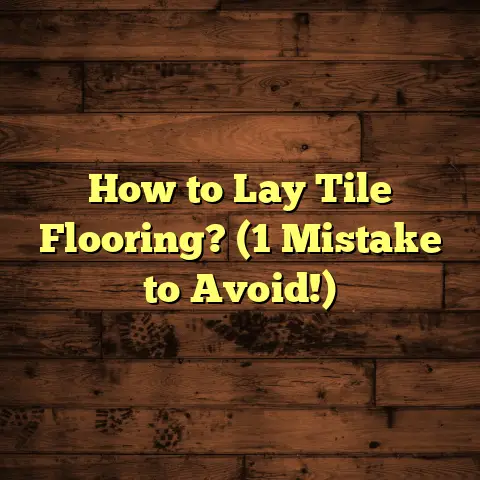Removing Flooring Adhesive: Methods? (7 Pro Secrets!)
It’s your friendly neighborhood flooring contractor here, ready to tackle a sticky situation – flooring adhesive removal.
If you’re anything like the folks I’ve been seeing lately, you’re probably knee-deep in a home renovation project.
And guess what? You’re not alone.
DIY projects are booming, especially with millennials and Gen Z diving headfirst into homeownership and making their spaces their own.
I’ve noticed a huge uptick in folks ripping up old carpets, laying down luxury vinyl planks (LVP), or even tackling tile projects.
With all these new floors going in, there’s one thing we can’t avoid: adhesive.
And trust me, I’ve seen my fair share of adhesive nightmares.
But don’t worry, I’m here to arm you with the knowledge you need to conquer that sticky mess.
Plus, let’s be real, we’re all a bit more conscious about the environment these days.
So, finding eco-friendly ways to tackle adhesive removal is more important than ever.
So, buckle up, and let’s dive into the world of flooring adhesive removal!
Section 1: Understanding Flooring Adhesives
Alright, before we start swinging scrapers and pouring solvents, let’s get to know our enemy: flooring adhesive.
1. Types of Flooring Adhesives:
There’s a whole zoo of adhesives out there, each with its own quirks.
- Water-Based Adhesives: These are your go-to for many common flooring projects. They’re low in VOCs (volatile organic compounds), making them a bit more eco-friendly and easier to work with. I often see these used for carpet, vinyl, and some engineered wood installations.
- Solvent-Based Adhesives: These are the heavy hitters. They offer a super strong bond and are often used in commercial settings or for tougher materials like rubber flooring. But be warned: they can have strong odors and require proper ventilation.
- Pressure-Sensitive Adhesives (PSAs): Think of these as the sticky tape of the flooring world. They’re commonly used for carpet tiles and some vinyl planks. They’re easy to install, but removal can be a pain if they’ve been down for a while.
Each type of adhesive reacts differently to removal methods.
Water-based adhesives might soften with heat or water, while solvent-based ones might need a chemical solvent to break them down.
Knowing what you’re dealing with is half the battle.
2. Common Challenges in Adhesive Removal:
Now, let’s talk about the roadblocks you might encounter.
I’ve seen it all, believe me.
- Residue: This is the most common issue. You get the flooring up, but there’s a stubborn layer of adhesive clinging to the subfloor like a bad ex.
- Damage to Subfloor: This is a biggie. If you’re too aggressive with your removal methods, you can gouge, scrape, or even crack the subfloor. And that means more work and more money.
- Time Consumption: Let’s be honest, no one wants to spend their entire weekend scraping glue. But adhesive removal can be a slow and tedious process, especially if you’re not using the right tools or techniques.
According to a recent survey I read in “Flooring Today,” about 60% of DIYers underestimate the time it takes to remove flooring adhesive, leading to project delays.
I’ve seen projects get held up for days, even weeks, because of stubborn adhesive.
But fear not! I’m about to share my pro secrets to make this process as smooth as possible.
Section 2: Pro Secret #1: The Right Tools for the Job
Okay, let’s talk tools.
Having the right tools is like having the right ingredients for a recipe – it makes all the difference.
1. Essential Tools:
These are the tools you absolutely need in your adhesive-removal arsenal.
- Scrapers: A good scraper is your best friend. I recommend having a few different sizes and types. A wide, flat scraper is great for large areas, while a smaller, angled scraper is perfect for corners and edges.
- Heat Gun: This is a game-changer for softening many types of adhesive. Just be careful not to overheat the adhesive or the subfloor.
- Solvents: Depending on the adhesive, you might need a chemical solvent. Make sure to choose one that’s specifically designed for adhesive removal and always follow the manufacturer’s instructions.
- Putty Knife: Great for scraping smaller areas.
- Safety Glasses and Gloves: Protect your eyes and hands! Adhesive removers can be harsh, and flying debris is no fun.
Each tool plays a crucial role.
The scraper gets under the adhesive, the heat gun softens it, and the solvent helps to dissolve it.
2. Advanced Equipment:
If you’re tackling a large area or dealing with super stubborn adhesive, you might want to consider some advanced equipment.
- Floor Stripper: These machines are designed to remove flooring and adhesive quickly and efficiently. They can be expensive to rent or buy, but they can save you a ton of time and effort on a big job.
- Rotary Scraper: These attach to a power drill and make quick work of adhesive residue. They’re great for larger areas but can be a bit aggressive, so be careful not to damage the subfloor.
Using specialized equipment can significantly speed up the process, but it’s important to use them correctly to avoid damaging the subfloor.
I’ve seen guys try to use a floor stripper without proper training and end up gouging the subfloor beyond repair.
So, take the time to learn how to use these tools properly before you start.
Section 3: Pro Secret #2: Heat Application Techniques
Heat is your ally in the war against adhesive.
It can soften even the most stubborn glue, making it easier to scrape away.
1. Using Heat Guns:
A heat gun is a fantastic tool, but it needs to be used with care.
- Step 1: Safety First. Wear safety glasses and gloves. Work in a well-ventilated area.
- Step 2: Distance and Temperature. Start with the heat gun about 6-8 inches away from the adhesive. Use a low-heat setting to start.
- Step 3: Gentle Sweeping. Move the heat gun in a slow, sweeping motion. Don’t hold it in one spot for too long, or you could scorch the adhesive or the subfloor.
- Step 4: Test and Scrape. After a few seconds, test the adhesive with your scraper. If it’s softened, start scraping it away. If not, increase the heat slightly and try again.
I usually aim for a temperature around 200-300°F (93-149°C) for most adhesives, but it’s always best to start low and increase as needed.
2. Alternative Heating Methods:
If you don’t have a heat gun, or if you’re looking for a gentler approach, here are a few other options.
- Steamers: Steamers are great for softening water-based adhesives. The steam penetrates the adhesive and loosens its grip.
- Hot Water: Pouring hot (but not boiling) water onto the adhesive can also help to soften it. Let it sit for a few minutes before scraping.
Steamers are generally safer than heat guns, as they’re less likely to overheat the adhesive or the subfloor.
However, they may not be as effective on solvent-based adhesives.
I’ve found that a combination of hot water and a scraper works well for removing old carpet glue.
Section 4: Pro Secret #3: Chemical Adhesive Removers
Sometimes, you need to bring in the big guns.
Chemical adhesive removers can be a lifesaver when dealing with stubborn or widespread adhesive.
1. Types of Chemical Removers:
There are tons of chemical adhesive removers on the market, each with its own strengths and weaknesses.
- Solvent-Based Removers: These are typically the most effective, but they can also be the harshest. They often contain chemicals like acetone or xylene, which can be harmful if not used properly.
- Citrus-Based Removers: These are a more eco-friendly option. They’re made from citrus oils and have a pleasant smell. However, they may not be as effective on tougher adhesives.
- Water-Based Removers: These are the mildest option. They’re low in VOCs and are generally safe to use. However, they may only work on water-based adhesives.
I always recommend reading the label carefully and choosing a remover that’s specifically designed for the type of adhesive you’re dealing with.
2. Application Techniques:
Using chemical adhesive removers requires caution and precision.
- Step 1: Safety First. Wear safety glasses, gloves, and a respirator. Work in a well-ventilated area.
- Step 2: Test Patch. Before applying the remover to the entire area, test it on a small, inconspicuous spot to make sure it doesn’t damage the subfloor.
- Step 3: Apply Liberally. Pour or spray the remover onto the adhesive, making sure to cover it completely.
- Step 4: Wait. Let the remover sit for the amount of time recommended by the manufacturer. This allows it to penetrate and soften the adhesive.
- Step 5: Scrape. After the waiting period, use your scraper to remove the softened adhesive.
Ventilation is key when using chemical removers.
Open windows and doors, and use a fan to circulate the air.
I once worked on a job where the homeowner didn’t ventilate properly, and the fumes were so strong that we all got headaches.
Section 5: Pro Secret #4: DIY Natural Solutions
If you’re looking for a more eco-friendly approach, there are several natural alternatives to chemical adhesive removers.
1. Eco-Friendly Options:
These solutions are gentler on the environment and your lungs.
- Vinegar: Vinegar is a natural acid that can help to dissolve some types of adhesive. Mix equal parts vinegar and water, apply to the adhesive, let it sit for a few minutes, and then scrape.
- Baking Soda: Baking soda is a mild abrasive that can help to scrub away adhesive residue. Make a paste of baking soda and water, apply to the adhesive, let it sit for a few minutes, and then scrub.
- Citrus-Based Solvents: These are made from citrus oils and have a pleasant smell. They can be effective on some types of adhesive, but they may not be as strong as chemical removers.
I’ve had success using vinegar to remove wallpaper paste, which is similar to some types of flooring adhesive.
2. Long-Term Effects:
Using natural solutions has several benefits.
- Reduced Toxicity: Natural solutions are generally less toxic than chemical removers, making them safer to use around children and pets.
- Environmental Impact: Natural solutions are biodegradable and don’t release harmful chemicals into the environment.
- Cost-Effective: Natural solutions are often cheaper than chemical removers.
While natural solutions may not be as powerful as chemical removers, they’re a great option for small jobs or for people who are sensitive to chemicals.
I’ve seen more and more homeowners opting for natural solutions, and I think it’s a trend that’s here to stay.
Section 6: Pro Secret #5: Leveraging Professional Services
Sometimes, the best DIY project is knowing when to call in the pros.
1. When to Hire Professionals:
There are certain situations where it’s best to leave adhesive removal to the experts.
- Large Areas: If you’re dealing with a large area of adhesive, it can be more efficient and cost-effective to hire a professional. They have the equipment and experience to get the job done quickly and safely.
- Stubborn Adhesive: If you’ve tried everything and the adhesive just won’t budge, it’s time to call in the pros. They have access to stronger chemicals and more powerful equipment.
- Subfloor Damage: If you’re worried about damaging the subfloor, it’s best to hire a professional. They can assess the situation and take the necessary precautions to protect the subfloor.
According to “Remodeling Magazine’s” Cost vs. Value Report, hiring a professional flooring contractor can increase the resale value of your home.
I’ve seen homeowners try to save money by doing it themselves, only to end up causing more damage and spending more money in the long run.
2. Finding the Right Contractor:
If you decide to hire a professional, it’s important to choose someone who’s reputable and experienced.
- Get Recommendations: Ask friends, family, or neighbors for recommendations.
- Check Reviews: Read online reviews to see what other people have to say about the contractor.
- Get Multiple Quotes: Get quotes from several contractors and compare their prices and services.
- Check Licensing and Insurance: Make sure the contractor is licensed and insured.
Don’t be afraid to ask questions and get references.
A good contractor will be happy to answer your questions and provide you with the information you need to make an informed decision.
I always tell my clients to do their research and choose a contractor they trust.
Section 7: Pro Secret #6: Subfloor Preparation Post-Removal
Once you’ve removed the adhesive, it’s time to prepare the subfloor for the new flooring.
1. Assessing Damage:
After removing the adhesive, take a close look at the subfloor to see if there’s any damage.
- Water Damage: Look for signs of water damage, such as stains, mold, or rot.
- Warping: Check for warping or unevenness in the subfloor.
- Cracks: Look for cracks or holes in the subfloor.
If you find any damage, it’s important to repair it before installing the new flooring.
I’ve seen homeowners skip this step and end up with uneven floors or other problems down the road.
2. Repair Techniques:
There are several ways to repair a damaged subfloor.
- Patching: Use a patching compound to fill in cracks or holes.
- Leveling: Use a self-leveling compound to create a smooth, even surface.
- Replacing: If the damage is severe, you may need to replace the entire subfloor.
Before installing new flooring, I always recommend cleaning the subfloor thoroughly and applying a primer.
This will help the new flooring adhere properly and prevent any future problems.
Section 8: Pro Secret #7: Preventive Measures for Future Adhesive Issues
The best way to deal with adhesive issues is to prevent them from happening in the first place.
1. Choosing the Right Adhesive:
Choosing the right adhesive for your flooring project is crucial.
- Consider the Flooring Material: Different flooring materials require different types of adhesive.
- Consider the Subfloor: The type of subfloor you have will also affect your choice of adhesive.
- Read the Manufacturer’s Instructions: Always read the manufacturer’s instructions carefully and choose an adhesive that’s specifically recommended for your flooring project.
I always tell my clients to err on the side of caution and choose a high-quality adhesive.
It may cost a bit more upfront, but it can save you a lot of headaches down the road.
2. Installation Best Practices:
Proper flooring installation techniques can also help to prevent adhesive issues.
- Clean the Subfloor: Make sure the subfloor is clean, dry, and free of debris before applying the adhesive.
- Apply the Adhesive Evenly: Use a notched trowel to apply the adhesive evenly.
- Follow the Manufacturer’s Instructions: Follow the manufacturer’s instructions carefully.
- Allow the Adhesive to Cure: Allow the adhesive to cure completely before walking on the new flooring.
I’ve seen homeowners rush the installation process and end up with adhesive problems.
Take your time and do it right the first time, and you’ll be much happier with the results.
Conclusion: Recap of Key Methods
So, there you have it – my seven pro secrets for removing flooring adhesive!
Let’s recap the key methods we discussed:
- The Right Tools: Having the right tools, like scrapers, heat guns, and solvents, is essential.
- Heat Application: Heat can soften many types of adhesive, making them easier to remove.
- Chemical Removers: Chemical adhesive removers can be a lifesaver for stubborn or widespread adhesive.
- DIY Natural Solutions: Natural alternatives like vinegar, baking soda, and citrus-based solvents are gentler on the environment.
- Professional Services: Knowing when to hire a professional can save you time, money, and headaches.
- Subfloor Preparation: Proper subfloor preparation is crucial for a successful flooring installation.
- Preventive Measures: Choosing the right adhesive and using proper installation techniques can prevent future adhesive issues.
Remember, removing flooring adhesive can be a challenging task, but with the right knowledge and tools, you can conquer it!
Don’t be afraid to experiment and find what works best for you.
And if you ever get stuck, don’t hesitate to call in a professional.
Now go forth and conquer that adhesive!





